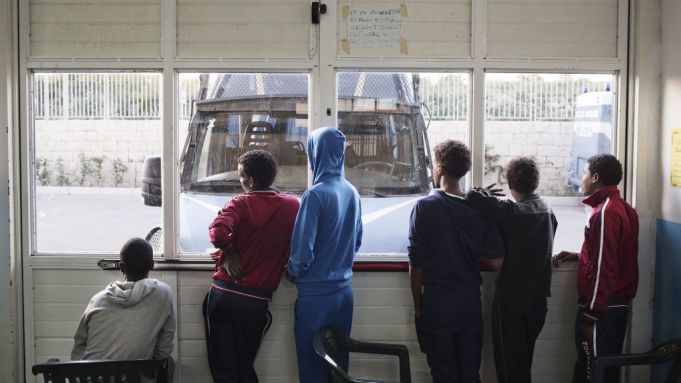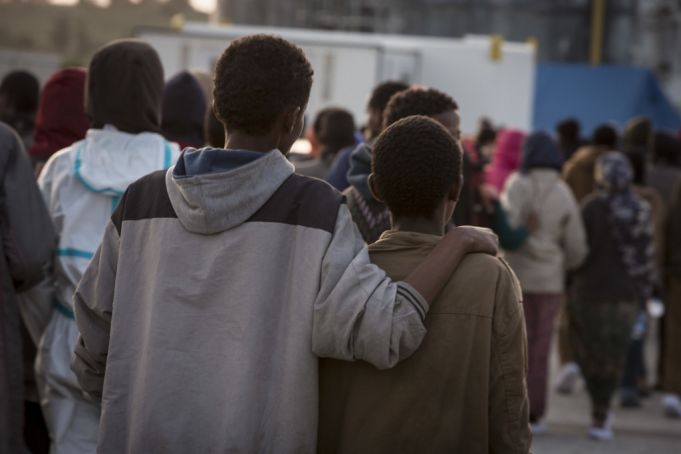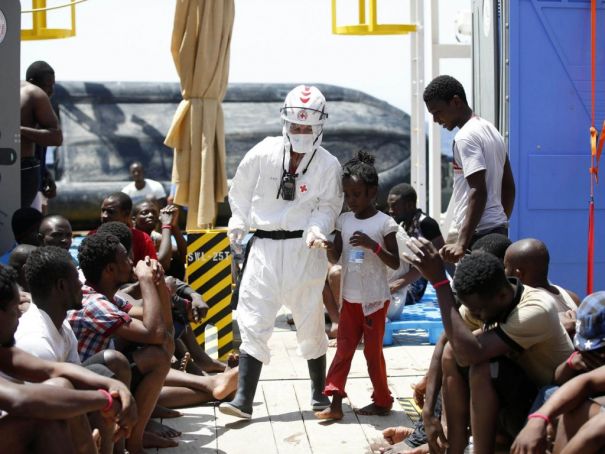Complicated legal procedures for minors and inadequate reception facilities drive many youngsters to abandon the system and make their own way.
Piazza Fiume may seem an unlikely place for a night shelter for unaccompanied foreign minors* in transit through Rome. Yet every day at around 21.00 a group of youngsters, typically aged between 14 and 17, makes the trek to A28 in Via Aniene 28 for food, clean clothes, a warm bed and the love and support of a small group of staff including a former unaccompanied foreign minor from Afghanistan who now studies political science at Rome’s Sapienza University during the day.
The shelter, run by Italian humanitarian organisation Intersos since 2011, has capacity for around 30 youngsters, although at the time of writing the actual number using the facility was lower. However, the operators said that with the onset of good weather and the consequent increase in sea crossings from north Africa the number is expected to grow. They also reported that significantly, this is the first year that A28 has never been empty.
Initially Afghans represented the largest national group using the shelter, but they have now been overtaken by Eritreans fleeing indefinite military service in the volatile Horn of Africa country. The large majority of guests are boys, and in the absence of separate sleeping arrangements girls have to make do with inflatable mattresses in the staff offices. Most stay for just a few nights before continuing their journey north. However, the operators said increasingly they are seeing unaccompanied minors return to A28 having been turned away at the border crossings at Ventimiglia, Como or Brenner. They also reported that a growing number of adolescents are now deciding to remain in Italy and begin integration programmes due to a greater understanding of the difficulties of pursuing their original plans to join friends or family in other parts of Europe.
Deaths during voyage to Italy
In 2016 181,436 migrants and refugees landed on Italy’s shores, up nearly 18 per cent over the previous year according to interior ministry figures. Of these 25,846 – or 14 per cent – were unaccompanied foreign minors, over twice the number that arrived in 2015. In addition, on the basis of the same percentage it can be assumed that around 700 of the over 5,000 migrants known to have died during the sea crossing to Italy in 2016 were unaccompanied minors, who had to face the horror of death by suffocation, crushing or drowning without a parent or other carer to hold their hand.

The jump in the number of unaccompanied minors travelling to Italy can be explained by the fact that “families in countries that do not qualify for the right to asylum are increasingly sending out their young people as a sort of advance guard”, according to Stefania Congia, head of the protection of foreign minors division of the immigration and integration policies department at the labour ministry. This is partly because in theory minors cannot be expelled other than for security reasons and automatically receive a permit of stay ‘for minority age’. More importantly, Congia pointed out that “only young people are able to survive the hardship of the journey to Europe”, which often includes a long and dangerous trek across the Sahara and/or a period of imprisonment, beating and torture in Libyan jails.
There were 17,373 unaccompanied foreign minors present in Italy as of 31 December 2016, up 45.7 per cent over the previous year according to labour ministry figures. Boys accounted for 93.7 per cent of the total, although the percentage of girls was on the rise. Over half came from – in descending order – Egypt, Albania, Eritrea, Gambia and Nigeria and almost all were approaching the age of majority, with 17 year olds alone accounting for 56.6 per cent, followed by 16 year olds at 26 per cent and 15 year olds at 9.8 per cent.
Irreperibili
In addition, the labour ministry reported that at the end of last year 6,561 unaccompanied foreign minors were officially ‘missing’, or irreperibili, having disappeared after being identified and assigned to a host structure. Of these, Egyptians were the biggest group by nationality (22.4 per cent), followed by Eritreans (21 per cent) and Somalis (19.1 per cent). These youngsters are of special concern to children’s rights organisations because they are particularly vulnerable to exploitation by smugglers and criminal organisations for illegal work, prostitution and the human organ trade.

Furthermore, the official number of missing may only represent the tip of the iceberg, as many youngsters may have slipped through the net before the authorities even became aware that they existed. In addition, in order not to get caught up in the complicated bureaucratic procedures for minors many lie about their age.
The irreperibili are largely the result of a break-down in the guardianship system and pressure on migrant reception facilities in Italy. These two factors combine to create uncertainty and frustration, driving impatient and determined young people to abandon their host structures and make their own way.
Administrative procedures
Unaccompanied minors need a guardian in order to complete all administrative procedures including applying for asylum, relocation and family reunification. In theory, the appointment should be made within 48 hours of the communication by the police authorities, but in reality the process can take much longer. In his extremely comprehensive and unbiased report of his fact-finding mission to Italy in October 2016 the Council of Europe's special representative on migration and refugees Tomáš Boček explains how this “creates a vacuum in terms of the child’s protection: no-one takes responsibility for progressing him or her through the system”.
In principle, the mayor of the municipality where the child is received is appointed as guardian, but the large concentration of unaccompanied minors in some places means that these mayors may have hundreds of children under their guardianship. Boček reports, for example, that in summer 2016 the mayor of Palermo was the guardian of 1,200 unaccompanied children, although by the time of his visit the number had fallen to 540. Consequently, the mayors tend to delegate their guardianship duties to the local social services or to the migrant reception facility directly. However, these organisations are typically very busy and have little time to provide the kind of constant and individual attention that is required.
However, positive change could be in store following definitive approval by parliament in late March of a long-awaited law improving protection for unaccompanied foreign minors in Italy. The provisions have been hailed by sector international and non-governmental organisations as the first comprehensive law in Europe specifically addressing this issue.

The law overhauls the reception system for unaccompanied minors, creating dedicated first reception centres and more places in second tier facilities and a shorter transfer time (a maximum of 30 days rather than the present 60) between the two. Importantly, it also puts a new emphasis on accommodation in foster families, which are now considered priority with respect to institutionalised care.
Juvenile courts
In addition, responsibility for appointing a guardian has passed from the ordinary court to the juvenile court. This, according to Congia of the labour ministry, should simplify and accelerate procedures considerably.
Crucially, the new law also establishes lists at every juvenile court of voluntary potential guardians (tutori volontari) who have been specially trained and declared eligible by the regional guarantor for infancy and adolescence. For information about training in Lazio see the website.
The law also introduces a total ban on turning unaccompanied foreign minors away at the Italian border and a new standardised procedure for identification and age assessment in the absence of official documents. In addition, it provides for the creation of a cartella sociale, or social-work file, to accompany the child through the system. Last but not least, it introduces a gentler transition period for those reaching the age of majority with the possibility of remaining in care until the age of 21.
Aid from humanitarian groups
Meanwhile NGOs and other groups continue to provide parallel services for unaccompanied foreign minors struggling to make their way in Italy. In Rome, it is the case of A28 – which is set to move to larger premises in the eastern suburb of Torre Spaccata this summer – and of the wifi, phone-charging and medical services provided by an Intersos mobile team at Tiburtina station. It is also the case of Civico Zero, a bustling day centre set up by Save the Children in the S. Lorenzo district offering psychosocial and legal assistance and creative activities, and of the basic support provided by the tenacious civil society organisation Baobab Experience near Tiburtina station.
In helping Italy meet its ‘parental duty’ towards these vulnerable young people all too often it is civil society organisations and concerned individuals that are called to step in.
Laura Clarke
*Unaccompanied minors: a legal definition
In Italy an unaccompanied foreign minor is defined anyone under the age of 18 who does not have Italian or other EU citizenship, has not applied for asylum and is, for any reason, within the territory of the state without care or representation by their parents or other adults who are legally responsible for them under existing Italian laws.
This article was published in the May 2017 issue of Wanted in Rome magazine.





















